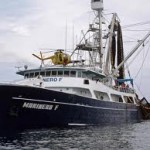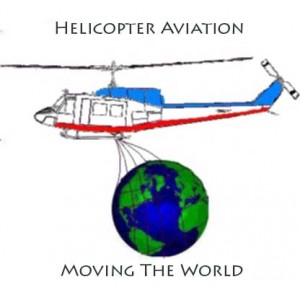



Back in the early 80s when the offshore oil business was dying out on the California Coast the new rage for the Helicopter industry was the tuna boats. Pilots liked it because it was an easy way to build hours and for the mechanics it was pretty easy duty taking care of one or maybe two jet rangers that only flew a few hours a day.
The deal was supposed to be you went out on the boat for an average trip of 45 to 60 days and got paid $2,500 a month plus a fixed amount per ton, for each ton of tuna that was caught when the boat emptied out at the end of the trip. Now I know this doesn’t sound like much money but back in 1983 it was almost a fortune.
I was to meet my boat in a place called Manzanillo, Mexico in the middle of February so the company flew me and one other Mechanic down from Southern California in a Lear 23. In case you have never had the opportunity to ride in a Lear jet model 23 you have missed one of the things in life that anyone in aviation should experience at least one time. The thing takes off and climbs like something out of the Apollo project and the pilot’s main job for the entire flight is to keep the aircraft from going too fast. The entire flight was less than 3 hours. After a short ride to the harbor where we met the boats, we put out to sea immediately upon our arrival. We had made the whole transition from a large, dry, solid hanger in the high desert of SoCal to the high seas in less than half of a day.
 On the tuna boat I met my pilot; for the sake of his privacy in case he is still alive we will just call him Sam for the duration of this story.
On the tuna boat I met my pilot; for the sake of his privacy in case he is still alive we will just call him Sam for the duration of this story.
Sam and I would be sharing a cabin directly below the heli-deck and right behind the bridge. The cabin wasn’t bad in itself, about the size of a cheap motel room with two bunks and two small closets as well as a couple of drawers under the bunks and one desk mounted to the wall between the bunks and beneath the only window. As I learned quickly the best part of the accommodations was that Sam and I had a bathroom and shower that was just for the two of us while the entire rest of the crew except the Captain was required to share one down below.
I, being the mechanic also got my own work shop. A small room about 10 foot square with a workbench built into one wall and places to strap down my tool box. Something I did not take too seriously until the first time I had to pick up all my stuff and put the box back together.
MY Tuna Baby was a Bell 206B3 with about 1800 hours on her when the trip started. She was on fixed floats and had an aluminum shield inside the co-pilots chin bubble to keep the Captain from dropping a bomb into the nose and subsequently blowing the nose off of the helicopter.
You see, when a helicopter is utilized to fish for tuna it works something like this. When the Captain gets the feeling, or inkling or whatever that the boat is in a good spot the helicopter is launched to go and look for the tuna, which school close to the surface and are plainly visible from just a few feet up. When and if, a school of fish is spotted, the boat is directed into the area and the large powerful motor boat referred to as the skiff that is attached to the back of the tuna boat is deployed which pulls the net off the back of the bigger boat and starts to make a circle around the school of fish. In the meantime, three or four small speed boats are put over the side by use of a davit system.
Now these small boats are very interesting, they are about 10 feet long and maybe 3 feet wide, made from aluminum with 1 inch diameter steel bar-stock for a keel and rub-rail. They have 95 horse power outboard motors and are set up so that the thrust of the motor holds it down in place but if they run over the net (or each other) the motor just flips up and then falls back into place with almost no interruption in thrust. And although there were no instruments on board to tell how fast they were going the little speed boats will out run a Jetranger on floats if the seas are calm. After the circling process starts the small boats and the helicopter are all used to sort of herd the tuna and keep them inside of the net until it can be closed. They do this by throwing fish bombs into the water. A Fish Bomb is about a third of a stick of dynamite weighted with sand and sealed with wax and they are very effective at scaring the fish, blowing up speed boats, and damaging the occasional helicopter. After the circle is complete the bottom of the net which is 240 feet down is closed like a purse string and then the net is winched back aboard slowly reducing the size of the circle until the fish are concentrated in a very small area right next to the boat.
Within the first week out I learned the first of many lessons I would on this trip. One was how much I love the sea and it has been said more than once, I was born a couple centuries too late. The second was that whatever you thought you knew about corrosion control was wrong and insufficient when you place a helicopter on the open deck of a 225 ft boat, twenty feet above the water. At least half of your maintenance time is spent just keeping it clean.
Things droned on endlessly for the first month or so and not much went on but we were not finding or catching the amount of fish that we should. That’s about when the trip started to get more interesting.
Early one morning, one of the other boats in the fleet ours belonged to, crashed its helicopter into the ocean and since the pilot and the captain were both okay, they decided they were going to stay out and try and fish without a helicopter. It seems they were flying along at full tilt boogie about four or five feet off the water when the pop out floats deployed spontaneously which forced the nose of the aircraft down violently and the pilot was not high enough to correct or slow down, so the Jetranger did a face plant and ended upside down in the ocean. The story was that the forward cells of the floats tore open during the impact and the rear ones would not support the weight, but I was told later by the pilot that the rear cells were holding the helicopter at a nose down angle leaving the crew of the boat no easy way to attach a crane so the captain ordered the remaining bags cut rather than waste the time required to solve the problem.
A couple of days later we were awakened by alarms going off and the captain yelling over the PA system that we were deploying the net because we had sailed up on a large school of fish in the dark. The sun was still an hour away so Sam and I sat up on the helicopter deck and watched the crew work. The whole thing was rather fascinating. The net was closed and pulled in like usual but before it was half on board there was a problem. The large, dense, school of fish that the captain had seen on the fish finder turned out to be a pod of Humpback whales. And they were not happy about the whole net thing. Before the whales destroyed the net and made good their escape, they pulled the net off the boat backward through the hydraulic winching system and as it was not designed with a reverse the damage was substantial. We headed for the closest port where we could get the parts for our boat and stretch the net out so the crew could make repairs. This marked my first time in Acapulco, Mexico… stay tuned for Part 2.